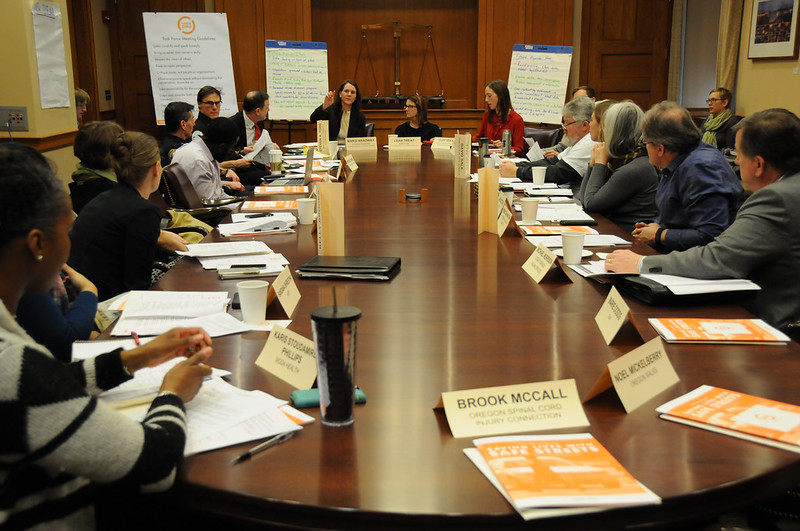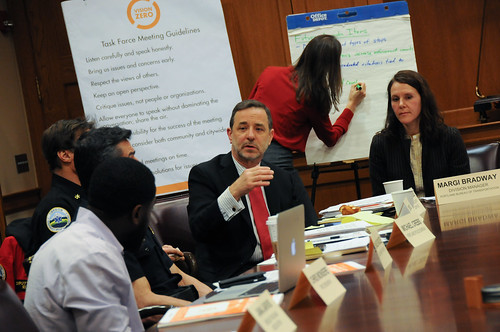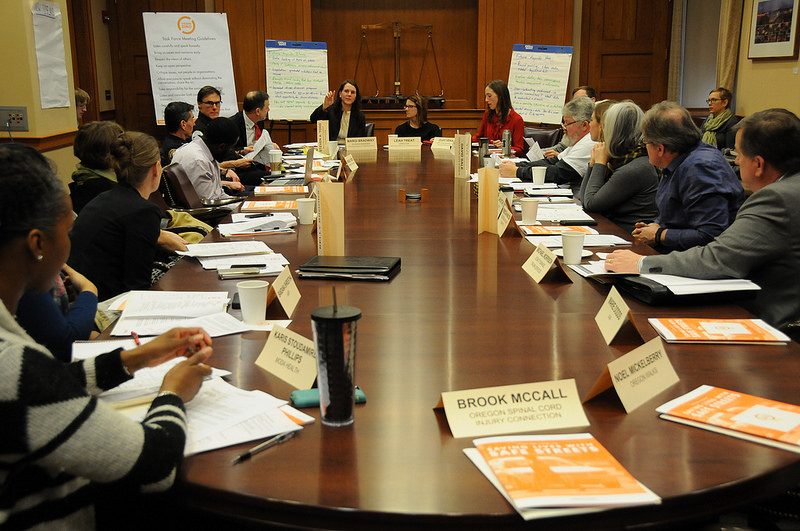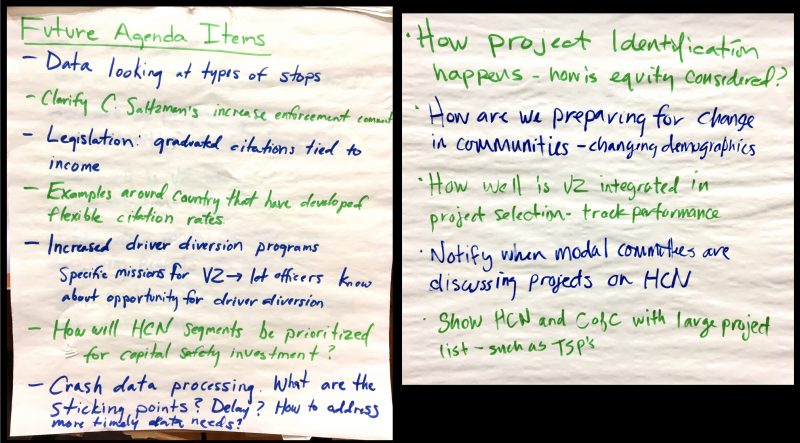
(Photo: J. Maus/BikePortland)
Just three short years ago Portland’s commissioner-in-charge of transportation hadn’t even heard of Vision Zero. Now the traffic safety concept is the target of more attention from the Bureau of Transportation than any other issue. More than paving streets, more than responding to historic snowstorms, and more than patching potholes.
“Every death on our roadways is a failure of government, a failure of our community, and a failure we refuse to accept.”
— Leah Treat, PBOT Director in a speech to Portland City Club in 2014.
On February 16th, the City of Portland notched their Vision Zero efforts up yet another level. At the first meeting of their Vision Zero Task Force since the Vision Zero Action Plan was adopted in December, the 26 city staffers and community advocates turned their energy toward implementation. This high-powered and impressively diverse group from a range of agencies, bureaus, and community organizations is just the tip of the spear when it comes to Vision Zero in Portland.
In three years, Vision Zero has become a potent coordinating principle that has galvanized city staff from a number bureaus, focused PBOT’s energy toward specific policies, programs, and projects, and brought a host of activists and community leaders to the table for important conversations about how to improve daily life on our streets. How did this happen? I’ve noticed several factors that have played a significant role…
PBOT Director Leah Treat
The Vision Zero relay began before Leah Treat was even on Portland’s team. But she grabbed the baton on the first days of her job and hasn’t stopped running since.
The idea of Vision Zero originally came from Sweden and Portland transportation leaders didn’t start to hear about it until 2010. Since then it grew in popularity and in practice with local transportation advocacy groups like Oregon Walks and The Street Trust (formerly the Bicycle Transportation Alliance). Former Mayor Charlie Hales supported the idea of Vision Zero, but never embraced it as an organizational compass the way Treat has.
Treat made Vision Zero a priority from Day One. She told the KBOO Bike Show in 2014 that she talked up the idea that “one person being killed on our roads is too many” to her staff during her first week on the job. After saying she’d include Vision Zero in a PBOT action plan document, Treat told City Club in April 2014 in her first major speech as director that, “Every death on our roadways is a failure of government, a failure of our community, and a failure we refuse to accept.”
PBOT staff support
Policy language and plans can seem like empty promises to activists, but they’re often required precursors to action. With Treat’s commitment and other key PBOT staff — like Active Transportation and Safety Division Manager Margi Bradway and Policy, Planning and Projects Group Manager Art Pearce (both of whom were at the February 16th task force meeting) — lined up in support of the idea, the Portland City Council unanimously passed a Vision Zero resolution in 2015. That was followed by passage of the Action Plan a year later. The plan included a robust public and stakeholder committee process that wouldn’t have happened without strong support from then PBOT Commissioner Steve Novick and former Mayor Charlie Hales. The passage of the plan gave PBOT and the public an opportunity to educate City Council members about the importance of traffic safety and the Vision Zero approach. That support from Council is a major reason why Vision Zero has such a full head of steam today.
Advertisement
The Task Force
I’ve followed many stakeholder committees over the years. I’ve never seen one as eager to volunteer their evenings than the one behind the Vision Zero Action Plan. And I’ve never seen one that not only has remained intact after the plan they worked on was adopted by council, but now wants to meet even more frequently than PBOT originally envisioned in order to get all the work done.

The committee itself is admirably diverse in terms of gender, race, and organizational representation. It includes members from; a health insurance company, a trauma nurse, the co-founder of the Black Parent Initiative, a transportation researcher, a circuit court judge, police officers, a deputy with the Portland Fire Bureau, and others. At their recent meeting they discussed issues like automated enforcement, the city’s legislative agenda, how to make crash data more timely and accurate, and how an increase in uniformed officers looking for traffic safety violations might impact places where many people of color live and work.
A Tragic 2016
Despite Portland’s best efforts, traffic deaths skyrocketed in 2016. With 45 deaths — several of them being high-profile incidents that put PBOT under pressure thanks to activists and the local media — PBOT had a real-life crisis on their hands. The freshly passed Vision Zero Action Plan and the support of staff and elected officials who helped pass it, gave them the ability to respond with authority and credibility. The city’s response to the safety emergency on outer Division is a prime example of how this played out.
Geography matters
Another factor that explains Vision Zero’s rise in Portland is geography. It just so happens that the same part of our city that has been historically neglected by transportation investments is also the place that suffers the most negative consequences from unsafe streets. Even before Vision Zero became a household word in Portland, East Portland advocates had begun to turn the trend of disinvestment around. Once the Vision Zero safety lens was added to the equity lens, the argument for putting money into programs and projects east of 82nd that would save lives became even stronger.
A new transportation commissioner
Commissioner Dan Saltzman is the most senior member of Portland City Council. When he was named as commissioner-in-charge of PBOT by Mayor Ted Wheeler, we didn’t know what to expect. So far what we’ve seen is a rock-solid commitment to traffic safety that is another reason why Vision Zero has so much momentum right now.
On February 16th, Saltzman started the day by telling Metro’s Joint Policy Advisory Committee on Transportation (where he represents PBOT), that, “Division Street is not a high crash corridor. It’s a death corridor. We are losing too many people there.” Later that same day he addressed the Vision Zero Task Force meeting by telling members, “We are very concerned about increasing accidents in our city and we’ll be listening very carefully to your wisdom and advice.” And just today he again used the “death corridor” line in a story about PBOT’s emergency speed limit plans published by The Oregonian.
Taken together, all of these elements have combined to make Vision Zero a powerful political force and organizing principle in Portland.
Evidence of momentum is easy to find. At the recent Task Force meeting PBOT unveiled a list of 15 safety projects on high crash corridors that will break ground this year. Seven of those projects are called out in the Vision Zero Action Plan. And fresh off their success garnering $1 million for a safety project on outer Halsey last fall, last week PBOT shared their first major Vision Zero-specific budget ask: a $2.2 million request of the City’s General Fund that would be split up between eight projects from the Vision Zero Action Plan (we’ll share more details in a separate post). PBOT has many needs. They could asked for General Fund money to pay for other projects or programs. But the agency has a clear directive right now: Vision Zero is their top priority.
I hope they don’t prove me wrong.
— Jonathan Maus: (503) 706-8804, @jonathan_maus on Twitter and jonathan@bikeportland.org
BikePortland is supported by the community (that means you!). Please become a subscriber or make a donation today.



